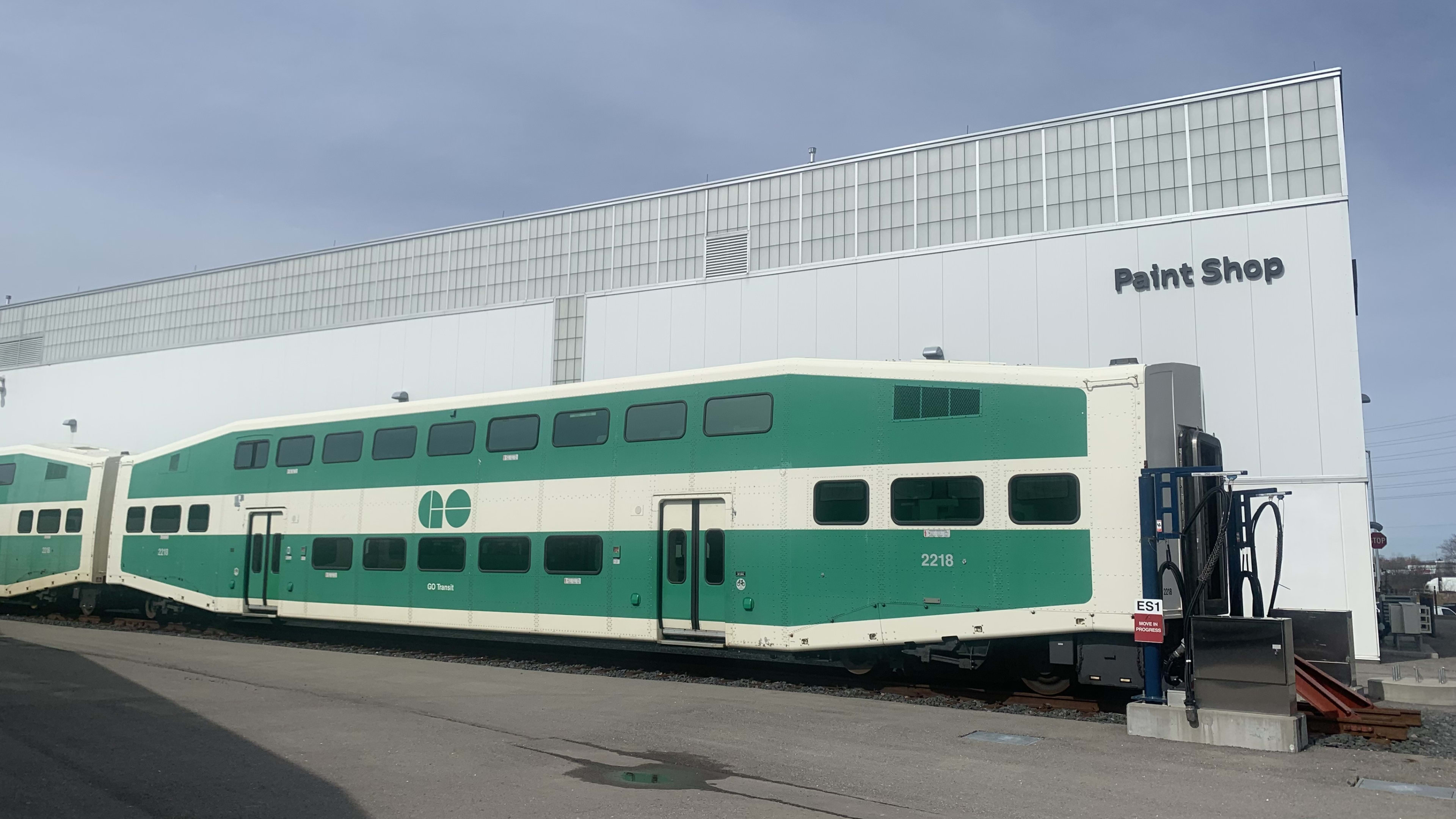An inside look at the people who make GO Trains look good
Workers from around the world are in Whitby, bringing new life to 150 refurbished GO Trains.
Apr 26, 2023
About a year ago Yurii Sementsov was working for a Ukrainian railway.
Back then, he never imagined coming to Canada and using his skills to lead quality control work on GO Train coaches.
He is responsible for maintaining a high standard as older, refurbished GO Train coaches go through a painstaking, month-long, four-step process. One that leaves them with a fresh, long-lasting coat of paint that will keep them looking good (and free from rust).
After fleeing Eastern Ukraine, Sementsov found himself on a route that took him through several countries before finally arriving in Canada, with his wife and two children, and settling in Vaughan.
Removing the old paint is the first step before a new coat can be added. (Mike Winterburn photo)
The whole family was touched by the warm welcome they received in Canada.
“None of us expected to see this friendly atmosphere here,” Sementsov said.
He was impressed with the professionalism he saw in the refugee process and added, “Everyone is here to help you.”
Initially hired as a mechanic, Sementsov now works out of Metrolinx’s Whitby Rail Maintenance Facility for Sygma Coating, which has the contract to repaint 150 older GO Train coaches there, after refurbishing work is done in North Bay and Thunder Bay.
GO Trains get a fresh coat of paint
The coaches being refurbished are at least 20-years old. Some are over 40. After this, they are expected to be in service for at least another 18 years.
Sementsov constantly checks the quality of work against a detailed set of standards and personally inspects everything from the evenness of sanding to the thickness of each paint coat – down to a fraction of a millimeter.
Yurii Sementsov, who performs quality control for Sygma Coating, inspects sanding work on the bare aluminum of a GO Train coach before painting. (Mike Winterburn)
The coating must be thick enough to prevent corrosion without wasting valuable paint.
“This job is very similar to my previous profession,” Sementsov said.
“A couple of years ago I worked in a facility where we were doing approximately the same work, but the shop equipment here is better.”
Once the stencil mask is removed, this freshly painted GO logo will stand out from a white backdrop. (Mike Winterburn photo)
Sementsov’s skills are in demand for more than one form of transportation. Brian Swaren, a senior asset manager at Metrolinx, see the similarities between paint work on trains and airplanes.
“They are about the same size, they use the same types of paint, and they are both made of aluminum,” Swaren said.
“The biggest difference is that we don’t have to paint any wings.”
Sementsov is one of seven Ukrainians on a team of 22. Most are new to Canada, including people from Peru, Guyana, Trinidad, Nicaragua, Cuba and Fiji.
“They are all highly skilled workers,” Swaren said.
“It’s not a job that just anyone could do.”
Douglas Garcia applied caulking to this coach before it was moved to the paint room. (Mike Winterburn photo)
Quality work takes time
With coaches coming out of the process at a rate of one per week, the project will provide three years of work before all 150 refurbished coaches are repainted.
Each coach spends about a week in one of four bays devoted to different stages in the process – stripping off the old paint; sanding down, cleaning and caulking the bare aluminum surface; applying new coats of paint; and putting on finishing touches.
The paint booth, used in the third stage, has impressive technology. It is sealed off from the rest of the building to ensure the cleanest possible paint job.
A new coat of paint is buffed by Andre Andrade. (Mike Winterburn photo)
Massive, state-of-the-art furnaces stand outside the room. They deliver hot air over the coaches, which gets sucked out through tunnels underneath.
The room is heated at 22°C for painting and then 60°C for a bake cycle. Each coat takes 30-40 minutes to dry and 16-24 hours to cure.
Seven coats are required for each coach and templates are used to form separation lines of coloured paint in the familiar two tones of green, white and black (which is technically a very dark shade of grey).
Premium fine edged masking tape is used on straight edges, providing crisp colour separation.
As with any paint job, masking tape is essential for creating straight lines. Logesan Reddy is taking care of that here. (Mike Winterburn photo)
A freshly repainted GO Train coach. (Metrolinx photo)
by Mike Winterburn Metrolinx communications senior advisor
